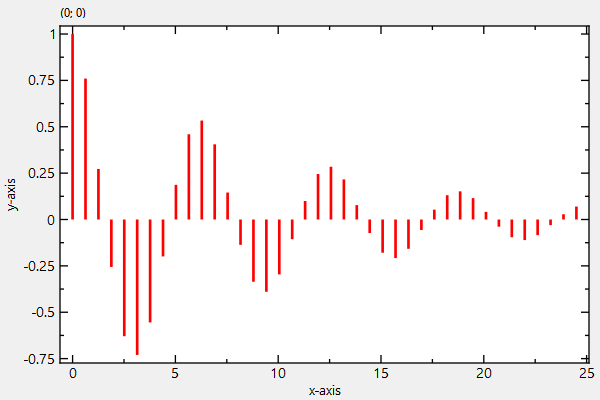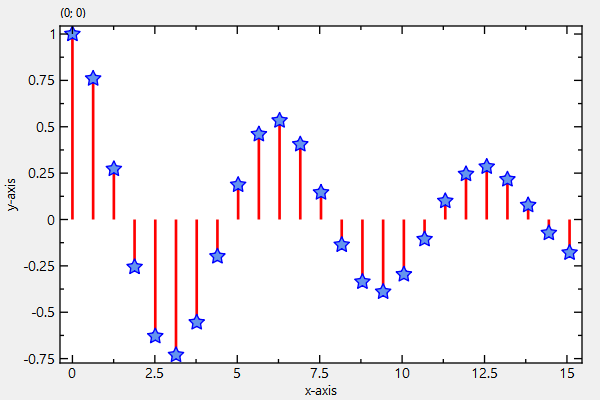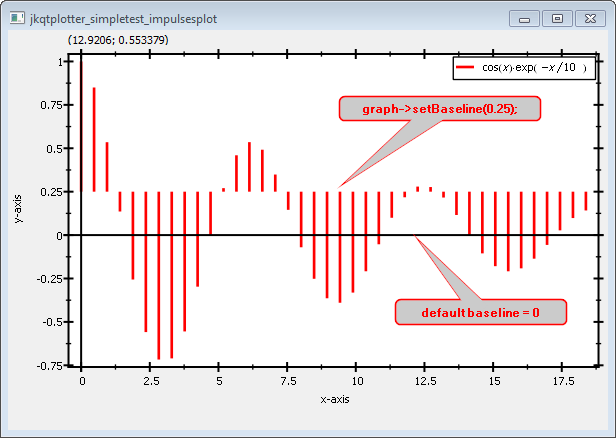mirror of
https://github.com/jkriege2/JKQtPlotter.git
synced 2024-11-16 10:35:49 +08:00
74 lines
2.7 KiB
Markdown
74 lines
2.7 KiB
Markdown
# Example (JKQTPlotter): Simple impulse plots {#JKQTPlotterImpulsePlots}
|
|
This project (see `./examples/impulsesplot/`) simply creates a JKQTPlotter widget (as a new window) and adds a single impulse graph.
|
|
The source code of the main application is (see [`impulsesplot.cpp`](https://github.com/jkriege2/JKQtPlotter/tree/master/examples/impulsesplot/impulsesplot.cpp).
|
|
|
|
|
|
|
|
First data for a curve is calculated and stored in `QVector<double>`:
|
|
```.cpp
|
|
QVector<double> X, Y;
|
|
for (int i=0; i<Ndata; i++) {
|
|
const double xx=double(i)/double(Ndata)*6.0*M_PI;
|
|
X << xx;
|
|
Y << cos(xx)*exp(-xx/10.0);
|
|
}
|
|
```
|
|
|
|
... and finally the data is copied into the datastore
|
|
```.cpp
|
|
size_t columnX=ds->addCopiedColumn(X, "x");
|
|
size_t columnY=ds->addCopiedColumn(Y, "y");
|
|
```
|
|
|
|
Now an impulse graph object is generated and added to the plot:
|
|
```.cpp
|
|
JKQTPImpulsesVerticalGraph* graph=new JKQTPImpulsesVerticalGraph(&plot);
|
|
graph->setXColumn(columnX);
|
|
graph->setYColumn(columnY);
|
|
graph->setLineWidth(2);
|
|
graph->setColor(QColor("red"));
|
|
graph->setTitle(QObject::tr("$\\cos(x)\\cdot\\exp(-x/10)$"));
|
|
|
|
plot.addGraph(graph);
|
|
```
|
|
|
|
The result looks like this:
|
|
|
|

|
|
|
|
There is an alternative class `JKQTPImpulsesHorizontalGraph` which draws horizontal impulse plots:
|
|
```.cpp
|
|
JKQTPImpulsesHorizontalGraph* graph=new JKQTPImpulsesHorizontalGraph(&plot);
|
|
graph->setYColumn(columnX);
|
|
graph->setXColumn(columnY);
|
|
graph->setLineWidth(2);
|
|
graph->setColor(QColor("blue"));
|
|
graph->setTitle(QObject::tr("$\\cos(x)\\cdot\\exp(-x/10)$"));
|
|
```
|
|
|
|
This code snippet results in a plot like this:
|
|
|
|

|
|
|
|
The classes `JKQTPImpulsesVerticalGraph` and `JKQTPImpulsesHorizontalGraph` also provide the ability to draw a symbol at the end of the impulse, e.g. using this code:
|
|
|
|
```.cpp
|
|
graph->setDrawSymbols(true);
|
|
graph->setSymbolType(JKQTPGraphSymbols::JKQTPFilledStar);
|
|
```
|
|
|
|
This code snippet results in a plot like this:
|
|
|
|

|
|
|
|
Finally you can move the baseline (i.e. the level, where the impulses start, which is typically x=0 or y=0) in the classes `JKQTPImpulsesVerticalGraph` and `JKQTPImpulsesHorizontalGraph`:
|
|
|
|
```.cpp
|
|
graph->setBaseline(0.25);
|
|
```
|
|
|
|
This code snippet results in a plot like this:
|
|
|
|

|
|
|